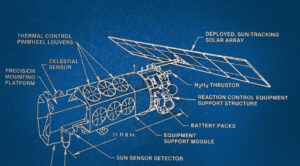Op-ed | Arming Warfighters with Advanced Weather Systems: What Must Happen Next
By Brian Berger

Weather plays a critical role in current and future military operations. For our nation’s defenders, understanding the effect of weather conditions is essential to planning and safely executing successful missions across the Joint Force. For example, clouds and their specific movement could be leveraged in route planning, or there could be a benefit to knowing if dense clouds are covering an area of interest.
Historically, our warfighters haven’t always been armed with the most advanced technology to forecast weather systems and gain an advantage over our adversaries. More recently, they have been working at a disadvantage that is only increasing with time, despite the technology being readily available for current deployment.
A Closer Look at History
In the 1960s, the U.S. government introduced the Defense Meteorological Satellite Program, or DMSP, a series of satellites that provides weather data for military operations, which is currently nearing the end of its use. Under Air Force operation, the satellites in the DMSP constellation are reaching the end of their life. Equipped with dated technology, many experts predict that these satellites may not last until a new solution is launched in a few years, potentially creating mission capability gaps for our warfighters and only making our adversaries stronger.
Climate change is a key national security consideration, and like other areas of its impact, we need to be creative in fielding solutions for the next future weather constellation to support our military. It’s time to strike while the iron is hot and arm our defenders with the proper tools and technology to operate safely and retain a combat advantage.
Disparate Data, Not the Answer
The Air Force and Space Force have been tasked to identify solutions to replace the DMSP satellites, and they are reviewing options, including potentially leveraging cubesat constellations as a solution to replacing DMSP. A cubesat is a type of miniaturized satellite normally used for space research, often powered by commercial off-the-shelf technology components. While a low-cost alternative that has some meaningful applications for Earth observation, there are many issues with this option as a replacement for DMSP, including:
- Smaller weather observations are often disaggregated, meaning warfighters would have to stitch together disparate data to attempt making informed decisions.
- The existing payload won’t meet the intent of what’s required in today’s weather systems. cubesats may provide smartphone-style imagery, but personnel safety and mission requirements require more than that.
- Most cubesats have a limited mission life, and this short life expectancy means our military forces will be faced with similar problems in a short amount of time once again.
Our warfighters need a long-term, high-fidelity weather information solution, which is the most alarming disadvantage to cubesat constellations. Our nation’s security depends on having a more advanced, strategic and permanent solution to include strong Theater Weather Imaging and Cloud Characterization capabilities, which the aerospace and defense industry can help provide to solve such an urgent problem.
The Keys to Long-Term Effectiveness
Having a mission-capable next-generation weather satellite system that meets warfighter operations and safety objectives is essential for our key national security interests in this era of climate change. It’s important to be creative as we identify a long-term, advanced weather systems solution. This creativity can be found in collaboration with aerospace and defense companies, an industry that has the experience and technology capabilities to get the job done and is rooted in government partnerships. This collaborative approach could include multiple agencies — the Air Force, the Space Force and the National Oceanic and Atmospheric Administration, to work together with the A&D sector for a permanent, government-owned system.
The long-term solution to permanently replacing DMSP cannot be an experiment. Amid a rapidly evolving environment, our nation’s security depends on having the right weather information system funded and in place, fast. Equipping our warfighters with the right data and intel on weather and the atmosphere can help operators make better-informed decisions on how to safely execute missions, ultimately ensuring we stay ahead of adversaries during a time when climate change and its impact are a top threat to our national security.
Paul Meyer is vice president of Space & C2 Systems for Raytheon Intelligence & Space, a business of Raytheon Technologies. He is responsible for advancing the business strategy and delivering against our customers’ current and future space missions.
May 24, 2021 at 07:37PM
via SpaceNews read more...

Post a Comment